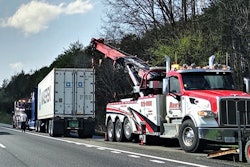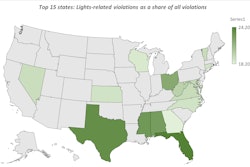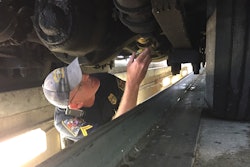Previously in this package: Two states, CVSA lead way in countering DataQs appeals bias
Updated May 24, 2024, to reflect the FMCSA's 2023 proposal to take more control of third-stage DataQs appeals. Also: Chris Turner, sourced in this 2021 feature, is no long with the Commercial Vehicle Safety Alliance.
Clark Freight Lines, with 180 trucks, used to routinely file lots of DataQs RDRs (Requests for Data Review) but met with little success, said Vice President Danny Schnautz. He gave the example of a violation for an air leak that wasn’t in fact a safety violation.
“What we found out was it made the police department really mad,” he said, particularly when the challenge was filed with little in the way of hard evidence. “Now we don’t dispute it unless we have real proof.”

He and others bring plenty of advice to the table about pursuing RDRs.
Navigating the system itself can be one challenge, but the most common hurdle is gathering enough evidence to make a persuasive case.

Focus on evidence and facts
As Schnautz suggests, setting up a successful DataQ begins at the scene of the crash or routine roadside or weigh station inspection. “I’ve worked with thousands of DataQs,” said Chris Turner, CVSA’s director of crash and data programs and a former Kansas Highway Patrol officer. “The best thing you can do as a carrier is to make sure your DataQ is legitimate.” Before ever filing, have the evidence on hand to communicate “not just where you feel something is wrong. Make sure you have an underlying set of facts that this is wrong.”
In Eagle Express owner Leander Richmond’s case detailed in the first part of this series, he came armed with the set of facts that accompanied his driver being pulled over and inspected, where a violation of the federal handheld-cell-use regulation was noted in an inspection report. He pointed to the language of that regulation, also adopted in Michigan state code (where his driver had been stopped), to show the rule as written was not violated by his driver.
Be savvy with your attitude
 Eagle Express owner Leander Richmond eventually had to bring to enforcement’s attention the language of the federal handheld-cell-use regulation to finally convince them that his driver had not violated the law.
Eagle Express owner Leander Richmond eventually had to bring to enforcement’s attention the language of the federal handheld-cell-use regulation to finally convince them that his driver had not violated the law.
Understanding the officer’s rationale, if it turns out to be in contradiction with whatever regulation he/she believes you’re violating, will give you part of what you need in any eventual challenge.
An officer’s writeup might be clearly incorrect, but in RDR filing “you don’t necessarily want to tell the officer they’re wrong because it’s not going to be received that well,” said Christopher Haney, director of safety and human resources for Payne Trucking, a 130-truck fleet based in Fredericksburg, Virginia. Instead, focus on “the regulatory perspective.” Make sure you or your drivers know enough to be able to collect the evidence to show where an officer “may have misunderstood the situation.”
Document the scene and equipment
“After a crash,” Turner added, “make sure everybody’s OK, then take the time to walk from one side of the scene to the other and snap photographs and take pictures of any violation – you want as many of the violations to be [marked] post-crash as possible.” Equipment problems that resulted from the crash “won’t be counted in your [carrier] SMS or [driver] PSP” profiles, where violations records are kept and made available to the public and prospective employers.
Carriers and drivers who are diligent during roadside stops and post-crash inspections “have a way higher success rate” than others, Turner said.
In one case for Payne Trucking, the company had a crash reported to its profile because the officer recorded the car in the collision as requiring a tow-away from the scene. (Accidents are recordable and become associated with a carrier’s record if there’s a fatality, an injury, or vehicle damage sufficient to require a tow-away.) However, a dashcam in the Payne truck “showed the officer getting into the car and driving it around … to where the truck picked it up.” The evidence effectively removed the crash from the carrier’s profile.
Haney echoes Turner when it comes to post-crash inspections, too, and the need for on-scene diligence for any driver. A driver’s notes and pictures about post-accident damage can mitigate against an inspector’s failure or error in designating violations as caused by the accident, a problem Haney says has gotten less prevalent in recent years.
“If they don’t identify on the inspection that these were post-accident damage, then it gets counted on the CSA BASIC,” he said. Such errors must be challenged, he said. In some cases, “this determines whether or not you get insurance next year.”
Another source of on-the-scene facts can be notes made by the inspecting officer, Haney said, which many truckers and carriers don’t realize they can request. Those notes can provide helpful information, such as giving insight to the officer’s rationale behind a violation.
Preparing to file a DataQ
If you’ve never filed an RDR, you’ll need a Federal Motor Carrier Safety Administration portal login set up if you’re a carrier with authority to use to access the system. If you’re a driver or leased owner-op, establish a login directly within the DataQs system itself, via DataQs.FMCSA.DOT.gov. There you’ll see the login module and the “My DataQs” section, where you start any review request.
“Make sure you get all your ducks in a row before you submit the DataQ,” said Trooper Jeremy Disbrow of Arizona. He said the fairly intuitive system guides you through the process to attach evidence, whether photos or electronic-log data downloads or other supporting documents.
Before starting, though, make certain you have what an FMCSA spokesman, speaking on background, referred to as the “report number” for the record you’re challenging. That should be shown in the CSA Safety Measurement System profile for your business or the Pre-Employment Screening Program report if you’re a driver or leased operator.
A police accident report, for instance, will likely have a different report number, the spokesperson said, so be sure to use the right one. If you provide the right record number and the inspection and violation are already within the system, DataQs will pre-populate much of the other information that the agency normally requests -- the inspection report number, the issuing state and date of inspection.
Be thorough and professional in filing
In your RDR, use language that shows intent to “be thoughtful, clear and concise in describing what the error is believed to be,” said the FMCSA spokesman, keeping in mind there are hardworking folks in the various state jurisdictions and in FMCSA itself on the other side of the computer “reading, reviewing and, ultimately, making a decision ... The FMCSA team strives to conduct themselves with courtesy, professionalism and respect – and such mutuality is appreciated.”
By submitting all required and otherwise pertinent information up front, said Disbrow, “it helps us get through more quickly" once the request makes it way to the appropriate state jurisdiction, if need be. "Usually, doing a back-and-forth over the span of weeks is what delays that process when we have to keep requesting documents.”
Don’t forget the final step in the process. Too many filers “do not carefully read and follow the instructions on the DataQs website,” said the agency spokesman. “Occasionally, we will learn about requests being automatically closed or otherwise rejected for the simple reason that the requestor failed to click ‘submit.’”
After you’ve filed
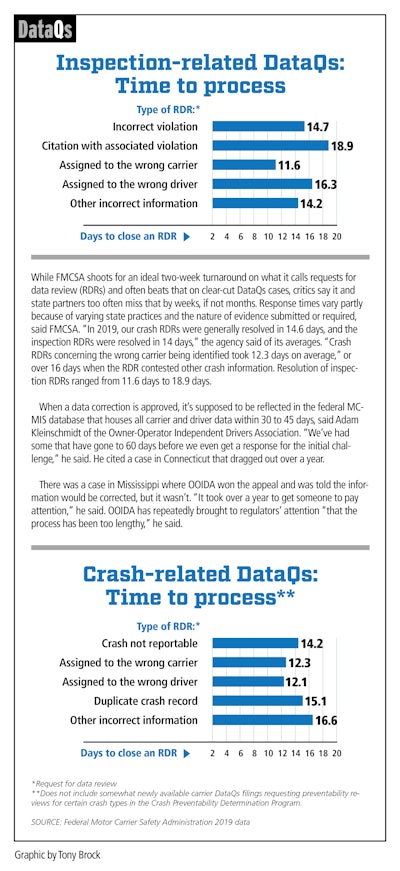
If your request is denied, don’t be afraid to appeal, said CVSA’s Turner. While there’s not an actual “appeal” button in the system, Turner advises to use the “reply again” function to “ask for an appeal to a secondary level or for a state training officer to look at it. They can usually look at it and say, ‘Yeah, that’s right,’ or not.”
Some states, like Minnesota and Arizona, have appeals review boards they convene for intractable disputes, but most don’t. When requesting an appeal above the first level, Turner notes the possibility of asking for review of any officer-shot video or inspection notes if it conceivably would back your argument.
After this story was originally reported in 2023, FMCSA proposed to take control of third-stage appeals centrally within the agency, requesting comment from trucking stakeholder with a notice. Time will tell whether new procedures for third-stage appeals come into play. As of May 2024, appeals processes remained similar to what's described here.
[Related: FMCSA proposes federal system for third-stage DataQs appeals]
Don’t neglect adjudicated citations
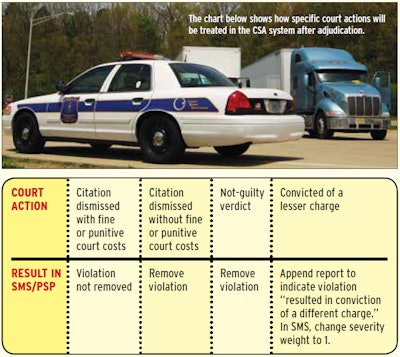 In 2014, FMCSA announced this policy for dealing with inspection-report-noted violations with associated citations adjudicated in a court of law. With the exception of a conviction of a lesser charge or the levy of punitive fines and court costs, adjudication of a citation can result in removal of the associated violation from carriers' Safety Measure System profiles and drivers' Pre-Employment Screening Program reports. The SMS record can be a key element of a carrier's ability to do business with freight partners and obtain affordable insurance. Hiring carriers rely on drivers' PSP reports in vetting backgrounds before a hiring decision is made.
In 2014, FMCSA announced this policy for dealing with inspection-report-noted violations with associated citations adjudicated in a court of law. With the exception of a conviction of a lesser charge or the levy of punitive fines and court costs, adjudication of a citation can result in removal of the associated violation from carriers' Safety Measure System profiles and drivers' Pre-Employment Screening Program reports. The SMS record can be a key element of a carrier's ability to do business with freight partners and obtain affordable insurance. Hiring carriers rely on drivers' PSP reports in vetting backgrounds before a hiring decision is made.
Perhaps the simplest route toward success in a violation challenge is when you’ve received a not-guilty verdict on in the court system for something associated with the citation/ticket. In 2014, FMCSA introduced a policy to remove violations from its system or reduce severity weighting if a ticket was thrown out by the court or if the cited driver was convicted of a lesser charge.
While this can prove to be low-hanging fruit, it can take a lot of time. The agency will ask for the inspection report number, the issuing state and date of inspection. For the citation, then, it wants the citation/ticket number and associated violation codes on the inspection report. Copies of court documentation, too, are required, and copies of both the ticket and inspection report are recommended.
As illustrated in the graphic from Part 3 of this package, violation challenges associated with citation adjudication are more likely than any other category to be successful, so don’t neglect to file a DataQ after a favorable court resolution of a ticket.
In some cases, this isn’t an option. Inspection-reported-noted violations that accompany written warnings, such as for speeding, can’t be taken to court – and therefore adjudicated – because no citation was issued.
You can of course find more helpful guides and information about compliance and safety, taxes, truck purchasing and so much more in the updated 2021 edition of the Overdrive’s Partners in Business manual for owner-operators and prospective owner-ops, sponsored by TBS Factoring Service and available for download via the link.
All of the stories and more in the "Setting the Record Straight" package:
Criticism mounts of DataQs crash/inspection-info review system
Correcting errors: How they can happen, how they hurt
Two states, CVSA lead way in countering DataQs appeals bias
How to mount an effective DataQs challenge
Podcast: Fairness in Minnesota's DataQs appeals process
